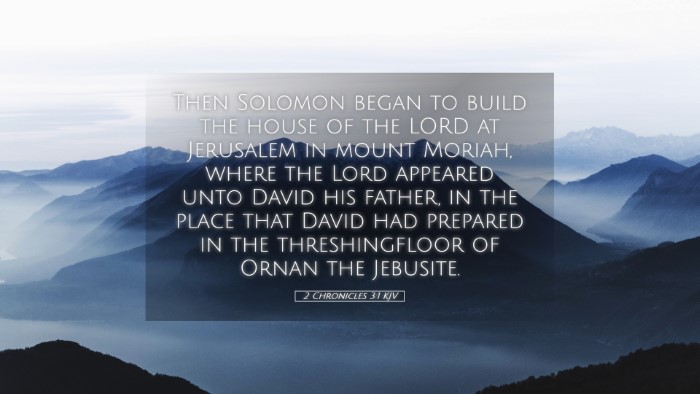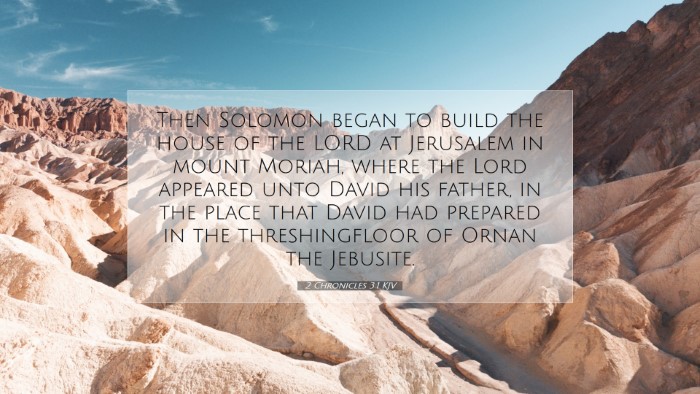Commentary on 2 Chronicles 3:1
Verse Reference: 2 Chronicles 3:1 - "Then Solomon began to build the house of the LORD at Jerusalem in mount Moriah, where the LORD appeared unto David his father, in the place that David had prepared in the threshing floor of Ornan the Jebusite."
Introduction
This verse marks a significant moment in biblical history, as it describes the commencement of the construction of the temple by Solomon, the son of David. This act not only fulfills a divine covenant but also embodies the promise of a permanent dwelling for the Lord among His people. The insights offered by various public domain commentaries can deepen our understanding of this pivotal moment.
Historical Context
Matthew Henry's Commentary: Henry emphasizes the importance of understanding the historical backdrop of this event. The construction of the temple represents a transition from the portable worship of the tabernacle to a permanent structure, symbolizing God's enduring presence. This shift is crucial in the narrative of Israel's relationship with God.
Albert Barnes' Notes: Barnes provides details on the geographical significance of Mount Moriah. He points out that this location is not merely incidental; it is deeply rooted in biblical history, as it is the site where Abraham prepared to sacrifice Isaac. Thus, the temple stands as a testament to the faithfulness of God throughout the generations.
Symbolism of the Temple
Adam Clarke's Commentary: Clarke explores the spiritual implications of the temple construction. He suggests that the temple symbolizes the presence of God among His people, serving as a physical representation of divine fellowship. In building the temple, Solomon acknowledges the nature of God as dwelling among humanity, which is central to Israel's identity.
Theological Reflections
The act of building the temple carries profound theological significance. It reflects themes of divine initiative and human response. The temple represents God's openness to dwell with His people, while human involvement in its construction signifies obedience and devotion.
Divine Choice
- God's Sovereignty: The choice of location signifies God's sovereignty over history. It reinforces the idea that sacred spaces are divinely ordained, chosen for specific purposes in God's redemptive plan.
- Historical Fulfillment: Solomon’s act can be viewed as the culmination of David’s preparations, highlighting that God's plans often span multiple generations and necessitate human cooperation.
Human Responsibility
- Obedience: The temple's construction is an act of obedience to God’s command, suggesting that human obedience is integral to God's promises.
- Preparation: David’s prior preparations, including materials and plans, emphasize the importance of being ready to serve God with our resources.
Spiritual Applications
This narrative encourages modern readers to consider their own spiritual temples, as Paul refers to believers as the temple of the Holy Spirit (1 Corinthians 6:19). Reflecting on the significance of Solomon's temple can inspire believers today to cultivate their lives as sacred spaces dedicated to the Lord.
Building Our Spiritual Temple
- Dedication: Just as Solomon dedicated the physical temple, we are called to dedicate our lives and actions to God's service.
- Corporate Worship: The temple serves as a reminder of communal worship. In the same vein, believers are encouraged to gather in worship, recognizing that the presence of God is among them.
Conclusion
2 Chronicles 3:1 is not merely a historical account; it is a profound testament to God’s enduring relationship with His people. The temple symbolizes God’s dwelling among humanity and calls for a response of obedience and reverence. As pastors, students, and scholars reflect on this text, they are reminded of the rich theological themes, historical significance, and personal applications woven into this moment in Scripture.


